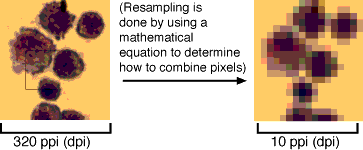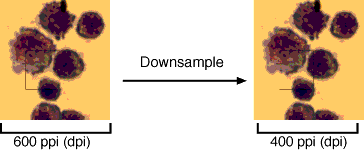- Thank you received: 0
My pareidolia knows no bounds.
11 years 5 months ago #21679
by rderosa
Replied by rderosa on topic Reply from Richard DeRosa
<blockquote id="quote"><font size="2" face="Verdana, Arial, Helvetica" id="quote">quote:<hr height="1" noshade id="quote"><i>Originally posted by Larry Burford</i>
<br />Prove it.
***
It sounds reasonable.
But I suspect it is not true.
LB
<hr height="1" noshade id="quote"></blockquote id="quote"></font id="quote">I will. As soon as I find my PaintShopProX CD. Like I said, I recently had to do a factory restore on my desktop and we also recently moved into a new house, so I either have to dig through boxes to find that CD or buy a new copy.
I think I might know where it is, so I'll look tomorrow.
You can always reduce resolution this way. Think about what happens when you move twice as far away and look at the same thing. Move twice as far again and look at the same thing. Now do it with a camera, each time taking a picture of the same thing. What you find is that as you move away a pixel (land-based measurement) gets bigger and bigger. Removing pixels from the hi-res (closest to the target) has the same affect.
I'll have to prove it to you with the Mt. Rushmore picture.
rd
<br />Prove it.
***
It sounds reasonable.
But I suspect it is not true.
LB
<hr height="1" noshade id="quote"></blockquote id="quote"></font id="quote">I will. As soon as I find my PaintShopProX CD. Like I said, I recently had to do a factory restore on my desktop and we also recently moved into a new house, so I either have to dig through boxes to find that CD or buy a new copy.
I think I might know where it is, so I'll look tomorrow.
You can always reduce resolution this way. Think about what happens when you move twice as far away and look at the same thing. Move twice as far again and look at the same thing. Now do it with a camera, each time taking a picture of the same thing. What you find is that as you move away a pixel (land-based measurement) gets bigger and bigger. Removing pixels from the hi-res (closest to the target) has the same affect.
I'll have to prove it to you with the Mt. Rushmore picture.
rd
Please Log in or Create an account to join the conversation.
11 years 5 months ago #21790
by rderosa
Replied by rderosa on topic Reply from Richard DeRosa
Here's a simple representation of reducing resolution by removing pixels

Note the leftmost image has 24 pixels (4 wide x 6 high) for a given land mass.
Now starting at the upper left corner, remove every other column of pixels in the X direction and every other row of pixels in the Y direction (downsampling) and you have the image in the center.
That's what happens when you move farther away. Not exactly, but very close. I used to do this kind of thing all the time.
Also notice how the loss of data is permanent. From the middle image, if you add those pixels back (upsample)you don't get that info back. The rightmost image has no more information than the center one. Just more pixels. All three images have the same land (object) size.
All high resolution means is more "resolved" pixels of information.
rd

Note the leftmost image has 24 pixels (4 wide x 6 high) for a given land mass.
Now starting at the upper left corner, remove every other column of pixels in the X direction and every other row of pixels in the Y direction (downsampling) and you have the image in the center.
That's what happens when you move farther away. Not exactly, but very close. I used to do this kind of thing all the time.
Also notice how the loss of data is permanent. From the middle image, if you add those pixels back (upsample)you don't get that info back. The rightmost image has no more information than the center one. Just more pixels. All three images have the same land (object) size.
All high resolution means is more "resolved" pixels of information.
rd
Please Log in or Create an account to join the conversation.
11 years 5 months ago #21680
by rderosa
Replied by rderosa on topic Reply from Richard DeRosa
Here's a more dramatic example, reducing from 320 pixels per inch to 10 pixels per inch:
Downsampling: In the example below, reducing the number of pixels per inch from 320 to 10, the image becomes very pixelated.

However, from 600 dpi to 400 dpi, as shown below, you aren't likely to see a difference, because our best printer has a limit of 400 dpi. The benefit of downsampling is that you get a much smaller file size that is easier to store and work with. But be careful! If you resample to lower resolutions than 300, your image will start to look pixelated.

jura.wi.mit.edu/bio/graphics/scanning/resolution.php
Less pixels = Larger pixel per land size
rd
Downsampling: In the example below, reducing the number of pixels per inch from 320 to 10, the image becomes very pixelated.

However, from 600 dpi to 400 dpi, as shown below, you aren't likely to see a difference, because our best printer has a limit of 400 dpi. The benefit of downsampling is that you get a much smaller file size that is easier to store and work with. But be careful! If you resample to lower resolutions than 300, your image will start to look pixelated.

jura.wi.mit.edu/bio/graphics/scanning/resolution.php
Less pixels = Larger pixel per land size
rd
Please Log in or Create an account to join the conversation.
11 years 5 months ago #21681
by rderosa
Replied by rderosa on topic Reply from Richard DeRosa
Remember the Wide Angle MOC Gallery low res images? Here's one example:
www.msss.com/moc_gallery/ab1_m04/images/M0106057.html
Pixel size 507 meters! (five football fields).
HiRise is 10 inches.
If I was a Moderator God, I would institute one rule:
If you want to post images from Mars, you have to do the kind of analysis I did with the Mt. Rushmore image where you calculate the land size of the image and the resultant land-based pixel size. If you want to see things start to make sense (or nonsense) in a hurry, that's the way to do it.
rd
www.msss.com/moc_gallery/ab1_m04/images/M0106057.html
Pixel size 507 meters! (five football fields).
HiRise is 10 inches.
If I was a Moderator God, I would institute one rule:
If you want to post images from Mars, you have to do the kind of analysis I did with the Mt. Rushmore image where you calculate the land size of the image and the resultant land-based pixel size. If you want to see things start to make sense (or nonsense) in a hurry, that's the way to do it.
rd
Please Log in or Create an account to join the conversation.
- Larry Burford
-
- Offline
- Platinum Member
-

Less
More
- Thank you received: 0
11 years 5 months ago #21682
by Larry Burford
Replied by Larry Burford on topic Reply from Larry Burford
Rich,
I misunderstood your point, and your reference. I guess I'm just too much of a 'boots (or tires) on the ground' kind of guy. I've been watching this and other discussions (where someone breathlessly announces PROOF) for so long I'm not paying enough attention anymore.
Sorry about that.
Yes, we might already have a photograph of an artificial object on Mars.
No, we do not have one that is unequivocal. Or even close, IMO.
***
One day, soon perhaps, we will put a large fleet of rent-a-rovers on Mars and thousands of humans will drive them around (from their living rooms or offices) and look at all sorts of stuff. And take pictures from a few feet away.
Then, maybe we will be able to answer some of the questions we have been asking ourselves.
I misunderstood your point, and your reference. I guess I'm just too much of a 'boots (or tires) on the ground' kind of guy. I've been watching this and other discussions (where someone breathlessly announces PROOF) for so long I'm not paying enough attention anymore.
Sorry about that.
Yes, we might already have a photograph of an artificial object on Mars.
No, we do not have one that is unequivocal. Or even close, IMO.
***
One day, soon perhaps, we will put a large fleet of rent-a-rovers on Mars and thousands of humans will drive them around (from their living rooms or offices) and look at all sorts of stuff. And take pictures from a few feet away.
Then, maybe we will be able to answer some of the questions we have been asking ourselves.
Please Log in or Create an account to join the conversation.
- Larry Burford
-
- Offline
- Platinum Member
-

Less
More
- Thank you received: 0
11 years 5 months ago #22088
by Larry Burford
Replied by Larry Burford on topic Reply from Larry Burford
<b>[rderosa] "That's what happens when you move farther away. Not exactly, but very close."</b>
I'm pretty sure this is what my intuition is trying to tell me. So the real question is how close does a specific formula for 'resolution reduction' come to reproducing the actual results of taking the picture from farther away.
A formula that averages neighboring pixels ought to do better than one that removes some and enlarges others.
I'm pretty sure this is what my intuition is trying to tell me. So the real question is how close does a specific formula for 'resolution reduction' come to reproducing the actual results of taking the picture from farther away.
A formula that averages neighboring pixels ought to do better than one that removes some and enlarges others.
Please Log in or Create an account to join the conversation.
Time to create page: 0.453 seconds
